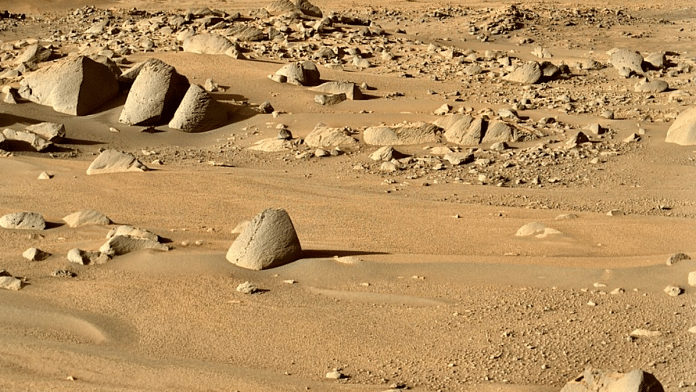New Delhi: Scientists have for the first time found cracked layers on tiny Martian dunes, which imply the Red Planet was a salt-rich watery world as recently as 400,000 years ago.
The researchers from the Chinese Academy of Sciences in Beijing studied data from China’s Zhurong rover. The rover has been exploring Mars’ northern hemisphere since May 2021. It has rolled close to four nearby crescent-shaped dunes in the Utopia Planitia region to investigate their surface composition.
All four of the miniature, wind-formed geological features are coated with thin, ubiquitously fractured crusts and ridges that formed thanks to melting small pockets of “modern water” sometime between 1.4 million years and 400,000 years ago.
Scientists have long thought that early Mars harboured abundant liquid water about three billion years ago. However, climate changes froze much of it as ice now locked in poles and left the bulk of the planet parched.
Researchers say water vapour travelled from Martian poles to lower latitudes like Zhurong’s spot a few million years ago, when the planet’s polar ice-caps released high amounts of water vapour, thanks to a different tilt that had Mars’ poles pointed more directly towards the sun. Frigid temperatures on the wobbling planet condensed the drifting vapour and dropped it as snow far from the poles, according to the latest study published in the journal ScienceAdvances. Read More
Also Read: Stellar crew of NASA’s Artemis moon voyage named & a possible ‘Himalayan’ error in glacier watch
Atomically thin transistors ‘grown’ on top of computer chips
Scientists have developed a new low-temperature growth and fabrication technology that allows the integration of 2D materials directly onto a silicon circuit, which could lead to denser and more powerful chips.
Emerging AI applications, like chatbots that generate natural human language, demand denser, more powerful computer chips. But semiconductor chips are traditionally made with bulk materials, which are boxy 3D structures. Therefore, stacking multiple layers of transistors to create denser integrations becomes very difficult.
MIT researchers, in their research work published in the journal Nature Nanaotechnology, have now demonstrated a novel technology that can effectively and efficiently “grow” layers of 2D transition metal dichalcogenide (TMD) materials directly on top of a fully fabricated silicon chip to enable denser integrations.
Growing 2D materials directly onto a silicon CMOS (Complementary metal–oxide–semiconductor) wafer has posed a major challenge because the process usually requires temperatures of about 600 degrees Celsius, while silicon transistors and circuits could break down when heated above 400 degrees.
Now, the interdisciplinary team of MIT researchers has developed a low-temperature growth process that does not damage the chip. The technology allows 2D semiconductor transistors to be directly integrated on top of standard silicon circuits.
The new technology is also able to significantly reduce the time it takes to grow these materials. While previous approaches required more than a day to grow a single layer of 2D materials, the new approach can grow a uniform layer of TMD material in less than an hour over entire 8-inch wafers. Read more
Also Read: NASA reveals new spacesuit for human mission to Moon & traces of glacier found near Mars’s equator
New rhynchosaur discovered in US
Scientists have discovered fossils of a lizard-like creature with a beak that ate plants around 232 million years ago in Wyoming in the US.
Researchers at the University of Wisconsin-Madison found fossils under a layer of sediment deposited in the Triassic era in what would have been rivers or lake beds at a time when Wyoming was part of the northern Pangean supercontinent, hundreds of millions of years ago.
The surface texture and morphological features of the initial specimens were too eroded for comparative use.
Using the unique dental morphology of 12 new specimens allowed paleontologists to confirm it as a new member of the order Rhynchosauria in the journal Diversity. Five specimens contained enough morphological information to identify them as belonging to Hyperodapedontinae, a sub-family of rhynchosaurs.
Rhynchosaurs are a group of extinct herbivorous reptiles. Members of the group are distinguished by their triangular skulls and elongated, beak-like premaxillary bones.
The taxonomic name of the new beast, Beessiiwo cooowuse, in the Arapaho language means “big lizard from the Alcova area” (Alcova being an area of central Wyoming), as the specimens were collected on lands of the Northern Arapaho.
At around half a metre in length, this big lizard was small by the standards of the big reptiles that would later dominate the landscape. Read more
(Edited by Richa Mishra)
Also Read: A room-temperature superconductor that works in low pressure, and losing Spock’s Vulcan



